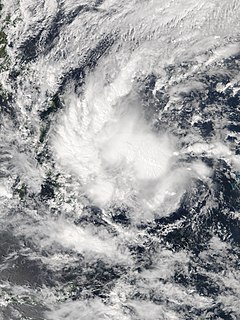The name Hanna or Hannah has been used for eleven tropical cyclones worldwide: five in the Atlantic Ocean and six in the Western Pacific Ocean. Hanna has also been used for one extratropical European windstorm.
The name Karen has been used for seventeen tropical cyclones worldwide: six in the Atlantic Ocean, nine in the Western Pacific Ocean, one in the South-West Indian Ocean, and one in the Australian region.
The name Anita has been used for thirteen tropical cyclones worldwide: one in the North Atlantic Ocean, one in the South Atlantic Ocean, two in the South-West Indian Ocean, and nine in the Western Pacific Ocean. The name Anita was retired in the North Atlantic after the 1977 hurricane season.
The name Betty has been used for a total of twenty tropical cyclones worldwide: one in the Atlantic Ocean, two in the South Pacific Ocean, one in the South-West Indian Ocean, and sixteen in the Western Pacific Ocean.
The name Alice has been used for eighteen tropical cyclones worldwide: four in the Atlantic Ocean, ten in the Western Pacific Ocean, one in the South-West Indian Ocean, and three in the Australian region.
The name Agnes has been used for a total of sixteen tropical cyclones worldwide: one in the Atlantic Ocean, thirteen in the Western North Pacific Ocean, one in the South-West Indian Ocean, and one in the South Pacific Ocean.
The name Helen or Hellen has been used for twenty tropical cyclones worldwide: sixteen in the Western Pacific Ocean, one in the North Indian Ocean, one in the South-West Indian Ocean, and two in the Australian region.
The name Lola has been used for seventeen tropical cyclones worldwide, fifteen in the Western Pacific Ocean, one in the South Pacific Ocean, and one in the South-West Indian Ocean.
The name Haishen has been used to name four tropical cyclones in the northwestern Pacific Ocean. The name was contributed by China. Its name means "God of sea".
The name Basyang has been used in the Philippines by PAGASA in the Western Pacific.

Typhoon Sanba, known in the Philippines as Typhoon Karen, was the strongest tropical cyclone worldwide in 2012. The sixteenth named storm and tenth typhoon of the annual typhoon season, Sanba formed as a tropical depression east of the Philippines on September 10. The storm gradually intensified as it moved generally northward in an area favorable for tropical development. The system was soon upgraded to a tropical storm less than a day after formation and subsequently further to a typhoon on September 12. Later that day, Sanba entered a phase of explosive intensification, quickly strengthening and gaining annular characteristics. On September 13, the system attained its peak intensity with maximum sustained winds of 125 mph (205 km/h), and a barometric pressure of 900 mbar, becoming the strongest typhoon in the Western Pacific Ocean since Megi in 2010. Accelerating towards more northerly latitudes, a period of gradual weakening ensued afterwards as its eye expanded. It made landfall on South Korea late on September 17 as a typhoon before transitioning into an extratropical cyclone the following day. Sanba's remnants tracked into the Primorsky Krai region of eastern Russia before they were last noted on September 19.

This timeline documents all of the events of the 2012 Pacific typhoon season, the period that tropical cyclones formed in the Western Pacific Ocean during 2012. Most of these tropical cyclones formed between May and November 2012. The scope of this article is limited to the Pacific Ocean, north of the equator between 100°E and the International Date Line. Tropical storms that form in the entire Western Pacific basin are assigned a name by the Japan Meteorological Agency (JMA). Tropical depressions that form in this basin are given a number with a "W" suffix by the United States' Joint Typhoon Warning Center (JTWC). In addition, the Philippine Atmospheric, Geophysical and Astronomical Services Administration (PAGASA) assigns names to tropical cyclones that enter or form in the Philippine area of responsibility. These names, however, are not in common use outside of the Philippines.

Typhoon Chaba, known in the Philippines as Typhoon Igme, was the fourth most intense tropical cyclone in 2016 and the strongest tropical cyclone to make landfall in South Korea since Sanba in 2012. Chaba also caused 7 deaths in the country. Typhoon Chaba was the eighteenth named storm and the eighth typhoon of the 2016 Pacific typhoon season.
The name Pamela has been used for eleven tropical cyclones worldwide, one in the Eastern Pacific Ocean and ten in the Western Pacific.

Tropical Storm Sanba, known in the Philippines as Tropical Storm Basyang, was a weak tropical cyclone that affected southern and central parts of the Philippines in mid-February 2018. Sanba developed as a tropical depression in the open Pacific Ocean on February 8. The system moved generally westward while slowly developing, finally attaining tropical storm status on February 11. Soon after, wind shear caused the system to lose organization and remain as a minimal tropical storm through February 11 and 12. During this time, Sanba moved westwards then west-northwestwards, making landfall over northeastern Mindanao on February 13. The system weakened into a tropical depression before making another landfall in southeastern Negros later that day. After traversing the Philippine Islands, Sanba failed to reorganize significantly in the Sulu Sea and dissipated two days later west of Palawan.
This page is based on this
Wikipedia article Text is available under the
CC BY-SA 4.0 license; additional terms may apply.
Images, videos and audio are available under their respective licenses.



